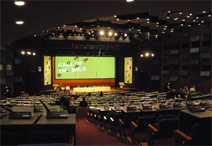Volume 10: Numéro
03
Octobre 2007
English
Newsletter

| Si vous désirez vous inscrire, avez des questions ou des suggestions ou si vous souhaitez contribuer au bulletin, SVP contactez Yann Vergriete, éditeur du bulletin ou David Galbraith, directeur exécutif du RCCF : yannvergriete@fastmail.fm dgalbraith@rbg.ca |
| 3. CITES CoP14 Plants Results, Adrianne Sinclair, CITES Scientific Advisor for Plant Trade
The 14th meeting of the Conference of the Parties (CoP14) to the Convention on the International Trade in Endangered Species (CITES) took place from June 3-15, in The Hague, Netherlands. There were 1250 participants representing 151 governments, inter-government and non-government organizations. The CoP meets every three years to amend the list of species regulated under the Convention in Appendices I and II. Species listed in Appendix I are endangered because of international trade and those in Appendix II could become endangered if trade is not regulated. Decisions on proposals are taken by a two-thirds majority of representatives present and voting. Sixteen scientific proposals were submitted to amend the listings for flora. Canada joined the consensus to delete the hybrid Agave arizonica from Appendix I, to transfer Nolina interrata from Appendix I to Appendix II, and to remove Pereskia spp. Quiabentia spp., Pereskiopsis spp. and Shortia galacifolia from Appendix II of CITES. The proposal to list Caesalpinia echinata in Appendix II was adopted by consensus with an annotation indicating the CITES listing “designates logs, sawn wood, veneer sheets including unfinished wood articles used for the fabrication of bows for stringed musical instruments." Proposals concerning listing Dalbergia retusa, D. granadillo, D. stevensonii, and Cedrela odorata were withdrawn in favour of a decision to consider further work on timber proposals overall. All other proposed amendments to CITES listings concerned annotations, which specify the types of specimens of species that are included under, or exempted from, CITES control. Canada joined the consensus to amend the annotations, designating specimens that require CITES permits, as follows:
Further, the footnote that applies to Orchidaceae spp.
included in Appendix II was amended as follows: a) Specimens are readily recognizable as artificially propagated and do not show any signs of having been collected in the wild such as mechanical damage or strong dehydration resulting from collection, irregular growth and heterogeneous size and shape within a taxon and shipment, algae or other epiphyllous organisms adhering to leaves, or damage by insects or other pest; and b i) when shipped in non flowering state, the specimens must be traded in shipments consisting of individual containers (such as cartons, boxes, crates or individual shelves of CC-containers) each containing 20 or more plants of the same hybrid; the plants within each container must exhibit a high degree of uniformity and healthiness; and the shipment must be accompanied by documentation, such as an invoice, which clearly states the number of plants of each hybrid; or b ii) when shipped in flowering state, with at least one fully open flower per specimen, no minimum number of specimens per shipment is required but specimens must be professionally processed for commercial retail sale, e.g. labelled with printed labels or packaged with printed packages indicating the name of the hybrid and the country of final processing. This should be clearly visible and allow easy verification. Plants not clearly qualifying for the exemption must be accompanied by appropriate CITES documents." Canada, as well as the Plants Committee, was in favour of monitoring the implementation of this footnote before wider application and therefore did not support a proposal to also include the genera Miltonia, Odontoglossum, and Oncidium. Finally, the CoP adopted the proposal to delete the annotation to Taxus chinensis, Taxus fuana and Taxus sumatrana in Appendix II and amend the annotation to Taxus cuspidata to read: "Artificially propagated hybrids and cultivars of Taxus cuspidata live in pots or other small containers, each consignment being accompanied by a label or document stating the name of the taxon or taxa and the text 'artificially propagated', are not subject to the provisions of the Convention." The annotation protects wild populations while reducing the administrative burden associated with wide use of the species in Canada for horticultural purposes and as plantation stock for production of pharmaceutical derivatives. For full information on CoP14 click on the Conference of the Parties
link at www.cites.org.
|


